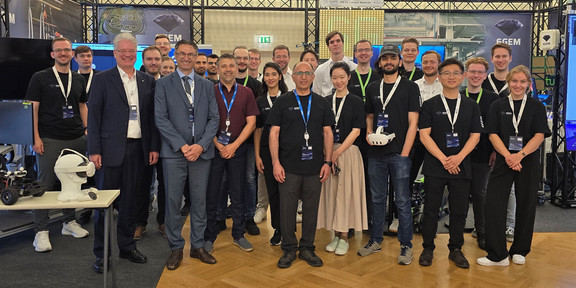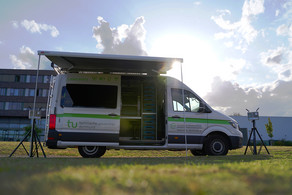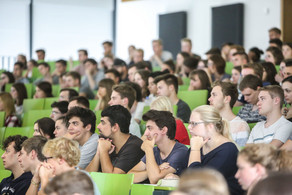Successfull participation at 6G conference in Berlin
- News
- News
- 6GEM

CNI specifically presented the following 5 demos at the 6GEM booth. Additionally a joint demo with 6G-ANNA partners was presented on the 6G-ANNA booth.
The following videos summarize three of the five demos:
Validation of innovative 6G concepts RISE and SEAMLESS for reliable teleoperation through digital triplet
Please confirm video activation.
After activation, cookies will be set and data is sent to YouTube (Google).
To the Google Privacy Policy
6GEM Real-time E2E Communication & Computing: 6G-supported collaboration of heterogeneous robots
Please confirm video activation.
After activation, cookies will be set and data is sent to YouTube (Google).
To the Google Privacy Policy
Communicating complex 6GEM solutions for immersive teleoperation using a gamification approach
Please confirm video activation.
After activation, cookies will be set and data is sent to YouTube (Google).
To the Google Privacy Policy
Detailed description of all shown demos and partnerships:
This is a more detailed escription of the 5 CNI demos:
Demo I: 6G-Edge cloud-assisted real-time control of humanoid robots by 6GEM concept for predictive real-time scheduling O-RACES
Key messages:
- Last year: single logistics robot evobot as digital twin (900 parameters)
- This year: 25 humanoid robots (130,000 parameters each) in the digital twin with optimized 6GEM Evolved- 6G Open RAN platform in "over-the-air operation"
- Research platform in use for various test fields: logistics, rescue robotics
Collaboration: TU Dortmund with Fraunhofer IML (Intralogistics)
A key 6G innovation is our open 6G Evolved Open RAN platform, which enables us to validate innovative system concepts in real system environments "over-the-air". Last year, we demonstrated this using the Evobot logistics robot developed by project partner Fraunhofer IML, which can also be seen again in the entrance tent. At our project meeting in Dortmund, we were now able to demonstrate the control of a real evobot (see video). The O-RACES concept, which has now been significantly enhanced, enables AI-supported real-time critical scheduling, with which even such time-critical processes as the control of a fleet of humanoid robots (each with 130,000 parameters) can be moved to the 6G Edge Cloud. By comparing proactive, dynamic O-RACES scheduling with reactive or static scheduling, our exhibit shows that 6G makes it possible to combine real-time scheduling with resource efficiency. In this example, you can see the parallel control of 25 digital twins of humanoid robots with a latency of less than 5 ms and greatly reduced spectrum requirements. In addition to robots, O-RACES can also be used to support other applications, shown here via our distributed load generation system STING.
Demo II: 6GEM Real-time E2E Communication & Computing: 6G-supported collaboration of heterogeneous robots
Key messages:
- Demonstration of the O-RACES concept using a networked robotics application with real robots, sensors and actuators
- Optimization of the time budget for real-time critical reaction to unpredictable situations in the 6G RAN (O-RACES) as well as in the 6G Edge Cloud (Real-time ROS2)
Collaboration: TU Dortmund CNI/DAES with DRZ (Rescue Robotics)
While the fleet of humanoid robots is presented in the digital twin, we have brought along another exhibit based on O-RACES, which realizes the collaboration of robots in the test field of rescue robotics. In the interaction between a robot that provides a video feed of a scene (in this case a hanging pole that can be triggered at any time), another robot reacts with an action - in this case catching the pole. Here too, O-RACES ensures that the reaction time is minimized, as the communication resources are proactively allocated based on the learned characteristics of the video feed. The collaborative nature of the tasks requires the interaction of heterogeneous robots. To this end, we have worked in 6GEM to enable the execution of ROS2 commands with predictable and minimized latency. Only through the interaction of communication and computing is it possible for the robot to operate in the "green zone".
Demo III: Integrated AI-supported network planning and operation of 6G mmWave networks with a focus on resource efficiency through the use of "zero energy" reflectors
Key messages:
- 6GEM key innovations: Intelligent reflector HELIOS in combination with AI-based propagation modeling DraGoN
- Illustrative demonstration of planning options using a real industrial environment
Collaboration: TU Dortmund with Fraunhofer IPT, RWTH, 6G-ANNA & 6GEMcubator
Another field of our research on 6G relates to resource-efficient network planning and the operation of high-performance networks for industrial environments. In this field, we have also worked closely with the 6G-ANNA lighthouse project. Our research focuses in particular on making efficient use of the mmWave spectrum at 26 GHz, which has hardly been used to date. Two key innovations are relevant here: Firstly, our 3D-printed Intelligent Reflective Surfaces (IRS) HELIOS allow radio field optimization using passive components. Over the past two years, we have already been able to present this concept live as a laboratory setup and a section of a production environment. In the meantime, the functionality of HELIOS has also been confirmed in an independent, international measurement campaign of various IRS/RIS approaches carried out by the EU project 6G Sandbox.. Furthermore, with our AI-based radio propagation modeling method DRaGoN, we have created the prerequisite for calculating precise REMs (Radio Environmental Maps) - without the effort associated with ray tracing. In our exhibit, we are now using the specific production environment of our partner Fraunhofer IPT to show that it is possible to address neuralgic areas in a production environment by using customized HELIOS reflectors. The great advantage here is that it is possible to dispense with an additional active component with an energy requirement of several hundred watts. Using the exhibit, you can see for yourself the different radio field conditions and the degree to which the requirements are met. If you really want to immerse yourself in the real scenario, you can do so using VR glasses and the associated digital twin of the radio network. The potential of an integrated planning and operating concept has also been explored in the Startup.Connect project PANGOLIN since June 2025.
Demo IV: Validation of innovative 6G concepts RISE and SEAMLESS for reliable teleoperation through digital triplet
Key messages:
- Radio channel aware, predictive video coding and seamless combination of 6G Network of Networks (NoN)à 6GEM RISE & SEAMLESS concepts
- Digital Triplet approach uniquely combines different levels of system realization: one real vehicle - multiple scaled vehicles - many virtual vehicles in the digital modelà Scalability in the focus of validation
Collaborations: TU Dortmund with RWTH IKA
Next, we demonstrated our work on future 6G applications using the next exhibit. Teleoperation of robotic systems and vehicles is considered one of the key emerging applications for 6G, because despite all efforts to make robots autonomous, humans will always be required when situations are particularly challenging. A reliable video stream of the environment is essential for safe teleoperation, e.g. in rescue robotics, logistics or road traffic. With our RISE method, which was also presented at the IEEE VTC two weeks ago, we can ensure that large-volume video streams are transmitted securely even under the harsh conditions of real radio environments. On the one hand, we proactively adapt the video codec based on predictions of the radio quality and, on the other hand, we combine several radio networks with our SEAMLESS approach. To be able to test this approach in road traffic scenarios, we were able to demonstrate the concept of the "digital triplet" with all three components at our 6GEM project meeting in Dortmund two weeks ago: This involved teleoperating a real research vehicle on the test track in Aldenhoven near Aachen from Dortmund. At the same time, this single vehicle was integrated into the scaled system environment in Dortmund, with several scaled vehicles following the vehicle in Aldenhoven in a platoon. This was made possible by merging both levels in a digital model of both system environments. This approach also allows system concepts to be examined at an early stage with regard to scalability, without the need for many of the very expensive real vehicles to be available right from the start.
Demo V: Communicating complex 6GEM solutions for immersive teleoperation using a gamification approach
Key messages:
- Air field hockey via robotic arms serve as an intuitive example for real-time critical 6G applications with high bandwidth requirements
- Different control concepts (video vs. digital twin) allow trade-off between realism and resource efficiency with challenging radio channelsà Wider audience understands the necessity and potential of 6G
Collaboration: TU Dortmund with testfields Rescue Robotics and Automotive
We also presented our air field hockey exhibit. With this exhibit, we have taken up the challenge of making the complexity of our diverse research results tangible for a wider audience at Hannover Messe Industrie. We are using the method of gamification - especially to appeal to younger people. The core of the exhibit is to carry out a real-time critical teleoperation. In addition to the direct control option, either a video stream supported by RISE is used or immersive control by means of a digital twin. This control option is particularly intuitive and also significantly more resource-efficient than transmitting the complete video data. Perhaps you would like to try out for yourself how difficult it would be to carry out the teleoperation with a disturbed video stream - and then compare this with the proactively controlled RISE video stream.





